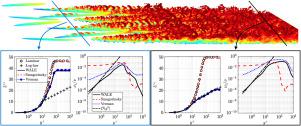当前位置:
X-MOL 学术
›
Comput. Methods Appl. Mech. Eng.
›
论文详情
Our official English website, www.x-mol.net, welcomes your
feedback! (Note: you will need to create a separate account there.)
Assessment of the wall-adapting local eddy-viscosity model in transitional boundary layer
Computer Methods in Applied Mechanics and Engineering ( IF 6.9 ) Pub Date : 2020-11-01 , DOI: 10.1016/j.cma.2020.113287 Minwoo Kim , Jiseop Lim , Seungtae Kim , Solkeun Jee , Donghun Park
Computer Methods in Applied Mechanics and Engineering ( IF 6.9 ) Pub Date : 2020-11-01 , DOI: 10.1016/j.cma.2020.113287 Minwoo Kim , Jiseop Lim , Seungtae Kim , Solkeun Jee , Donghun Park

|
Abstract The main idea of this manuscript is to assess the wall-adapting local eddy-viscosity (WALE) model, which is designed for large-eddy simulation (LES) of turbulent boundary layer, in transitional flow. In contrast to many other sub-grid-scale (SGS) models, the WALE model demonstrates the asymptotic decay of the eddy viscosity in the vicinity of a solid wall in turbulent boundary layer without relying on a dynamic procedure on the SGS model coefficient. Furthermore, the WALE model yields zero eddy viscosity in pure shear flow. Such features are attractive for LES of laminar-to-turbulent transition, yet the WALE model has not been thoroughly investigated in transitional boundary layer flow. Well-resolved LES is conducted for canonical boundary layer transition triggered by sub-harmonic resonance. The model formulation is thoroughly analyzed in the transition process. The asymptotic behavior of the two major tensors, i.e., the strain rate tensor and the traceless tensor of the velocity gradient squared, are confirmed in the current well-resolved LES. The cubic decay of the eddy viscosity in the wall distance is confirmed from the asymptotic analysis on the transitional flow. The presence of the strain rate in the model formulation generates practically zero eddy viscosity in the pre-transition region, allowing interactions of small-amplitude instabilities. The traceless tensor of the velocity gradient squared escalates if small-scale eddies appear, leading to sizable eddy viscosity particularly in the log-law layer in turbulent flow. The response of the WALE model to grid resolution is also discussed. The performance of the WALE model is compared to two other SGS models, Smagorinsky and Vreman models with a constant coefficient, in the current transitional wall-bounded flow.
中文翻译:

过渡边界层中壁面适应局部涡粘性模型的评估
摘要 本手稿的主要思想是评估壁面适应局部涡粘性 (WALE) 模型,该模型专为过渡流中湍流边界层的大涡模拟 (LES) 而设计。与许多其他亚网格尺度 (SGS) 模型相比,WALE 模型展示了湍流边界层中固体壁附近涡粘性的渐近衰减,而不依赖于 SGS 模型系数的动态过程。此外,WALE 模型在纯剪切流中产生零涡粘性。这些特征对于层流到湍流过渡的 LES 很有吸引力,但 WALE 模型尚未在过渡边界层流中得到彻底研究。对由次谐波共振触发的典型边界层跃迁进行了分辨率良好的 LES。在过渡过程中对模型公式进行了彻底分析。两个主要张量的渐近行为,即应变率张量和速度梯度平方的无迹张量,在当前分辨率良好的 LES 中得到证实。从过渡流的渐近分析证实了壁距中涡粘性的三次衰减。模型公式中应变率的存在会在过渡前区域产生几乎为零的涡粘性,从而允许小幅度不稳定性的相互作用。如果出现小尺度涡流,速度梯度平方的无迹张量会增加,导致相当大的涡流粘度,特别是在湍流中的对数定律层。还讨论了 WALE 模型对网格分辨率的响应。
更新日期:2020-11-01
中文翻译:

过渡边界层中壁面适应局部涡粘性模型的评估
摘要 本手稿的主要思想是评估壁面适应局部涡粘性 (WALE) 模型,该模型专为过渡流中湍流边界层的大涡模拟 (LES) 而设计。与许多其他亚网格尺度 (SGS) 模型相比,WALE 模型展示了湍流边界层中固体壁附近涡粘性的渐近衰减,而不依赖于 SGS 模型系数的动态过程。此外,WALE 模型在纯剪切流中产生零涡粘性。这些特征对于层流到湍流过渡的 LES 很有吸引力,但 WALE 模型尚未在过渡边界层流中得到彻底研究。对由次谐波共振触发的典型边界层跃迁进行了分辨率良好的 LES。在过渡过程中对模型公式进行了彻底分析。两个主要张量的渐近行为,即应变率张量和速度梯度平方的无迹张量,在当前分辨率良好的 LES 中得到证实。从过渡流的渐近分析证实了壁距中涡粘性的三次衰减。模型公式中应变率的存在会在过渡前区域产生几乎为零的涡粘性,从而允许小幅度不稳定性的相互作用。如果出现小尺度涡流,速度梯度平方的无迹张量会增加,导致相当大的涡流粘度,特别是在湍流中的对数定律层。还讨论了 WALE 模型对网格分辨率的响应。


















































 京公网安备 11010802027423号
京公网安备 11010802027423号